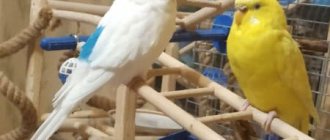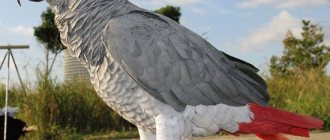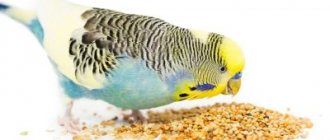Budgerigars are small, smart birds with bright plumage and a cheerful character. Due to their unpretentiousness and wide range of existing colors, they are very popular among lovers of ornamental birds and are often kept as pets.
Let's find out what types of budgies there are depending on the color of their plumage.
History of the discovery of the species
In the second half of the eighteenth century, a new continent was discovered. People learned about the kangaroo and the marsupial wolf, and the discoverers were also delighted by the abundance of unfamiliar birds. In 1805, the new species was already being studied by ornithologists, and at the same time the first drawing appeared, accurately reflecting the external features of the budgerigar.
In 1931, Londoners were able to see a stuffed animal of this bird in the museum, and in 1840, detailed information about its life in the wild appeared. Travelers' diaries told of huge flocks of colorful, cheerfully chirping birds that flock to watering holes or flutter through the tall grasses of the plains, pecking at ripe seeds.
The history of the appearance of the parrot
How are albinos different?
Due to their unusual appearance - amazing white plumage, on the surface of which waves are barely visible, these birds are in great demand. As you know, representatives of birds with snow-white plumage are called albinos.
Individuals of this species are excellent singers, able to quickly memorize and repeat words, and are very talkative.
Among the distinctive features of albinos are:
It is the color of the wax that allows you to unmistakably determine who is in front of you: a charming female - she is white or a handsome male - the owner of a pink beak.
What colors do budgies come in?
Only pure red is not found, although there are quite a large number of shades. You can find blue and black, variegated, yellow-blue, opal. There are red-eyed albinos, bright yellow lutinos (bred due to pigmentation disorders, this is not inherited). In general, ornithologists count more than two hundred types of budgerigar colors.
What colors do budgies come in?
Green
The chest, belly, and lower back are rich in color. There are black stripes on the throat that extend into purple spots on the cheeks. Wings, back, head, neck with sinuous lines, flight feathers are almost black on the wings, blue on the tail. A bright yellow mask completes this magnificent picture. Very elegant birds!
Blue
The dark factor - cobalt blue gives an interesting combination: based on the blue on the abdomen, chest, back, long tail feathers, the white head with a black wavy border glows brightly. It also emphasizes the white on the bird’s cheeks, wings, and back. Black or blue flight feathers add contrast.
Blue
This breed was bred in Belgium, and the chicks were raised much later in France. These are very beautiful birds: bright blue chest, belly, lower back, white head, black spots on the throat, spreading to purple cheeks. On a snow-white basis there are black waves of the pattern. The tail has a turquoise tint, all flight feathers are blue or black.
Blue coloring of the parrot
Yellow (Lutinos)
Bright lemon or canary plumage with pearlescent spots on the cheekbones. The eyes are red, like albinos, and the paws are scarlet. The feathers in the center of the wings and tail are lighter than the rest. In boys, the cere is purple or pink, while in girls it is dark and brown.
Read also
Why does a budgie hide its head under its wing?
White (albinos)
In Germany in 1932, pure white, red-eyed budgies with pink cere for boys and brown for girls appeared. Representatives of this breed do not live long and are susceptible to a variety of diseases. Often born with physical defects.
Spangles
They differ from ordinary birds in the pattern on their plumage - the pattern of waves is reversed. Blue wavy birds have white wings. The green ones have yellow. The ends of the feathers are edged with a thin black line along each feather.
Family of budgerigars. Documentary.
Purple
Purple birds with a black sinuous pattern on the wings, on the back, head and cheeks appeared in Germany in 1928. Throat with black markings, mask white. Turquoise marks the tail, charcoal marks the wings.
Yellow-green
This is the traditional color of budgerigars living in their natural habitat. There is no dark shade, so the color is more saturated, emerald, glossy, like Australian grass. A mask as bright as yolk, highlighted by shiny anthracite throat marks that extend into the violet cheeks. Blue tail, green on wings much darker than the rest.
Rainbow
The color is rare, obtained due to complex combinations of genes of white-winged, opaline and yellow-faced parrots. No two identical birds are born in this breed.
Grey
White on gray is a wonderful combination, and if you emphasize it with flowing dark lines of the design, it turns out extremely elegant.
https://www.youtube.com/watch?v=Bwl3JSEvPeI
Black
This breed can be called the newest, since the black wavy appeared only in 1998 in Germany. It is such a dark gray color that it has rightly been compared to charcoal. And the color was called anthracite.
Whitewings
They are actually blue or green budgies brought to Europe from Australia in 1933. Only the neck, back and wings are white. Interestingly, the characteristic sinuous lines are completely absent.
Harlequin
These are rare birds with amazing color differentiation. For example, blue on the chest is adjacent to yellow on the stomach and contrasts very brightly. It is from the combination of colors on the chest and belly that this species gets its name. No matter how the back is painted, this does not affect the characteristics. Usually this species is multi-colored, one of the most attractive, but few such chicks are born and survive.












